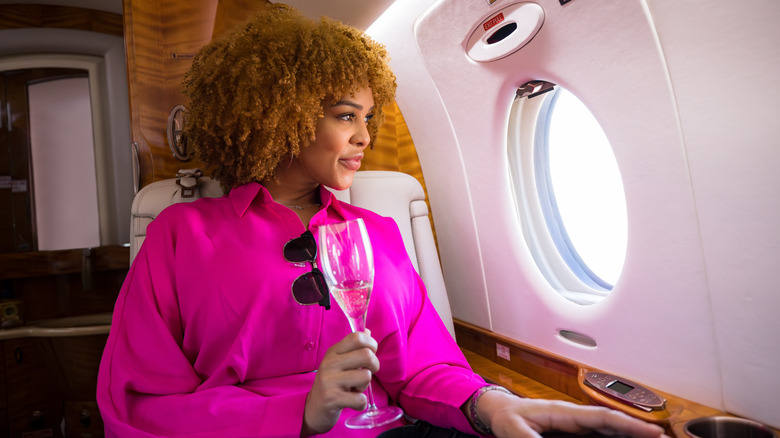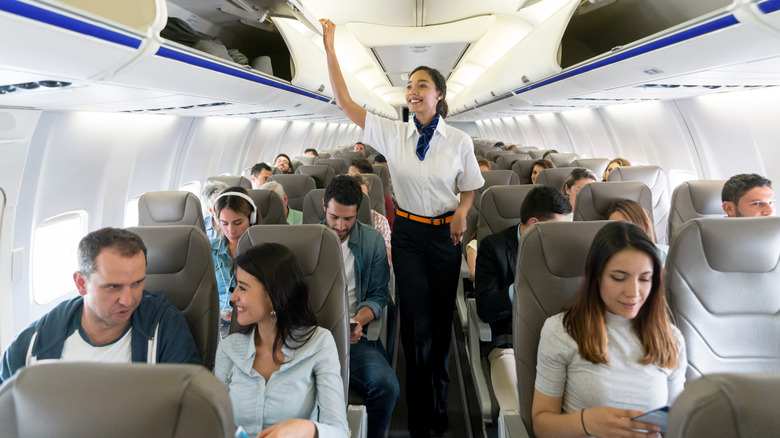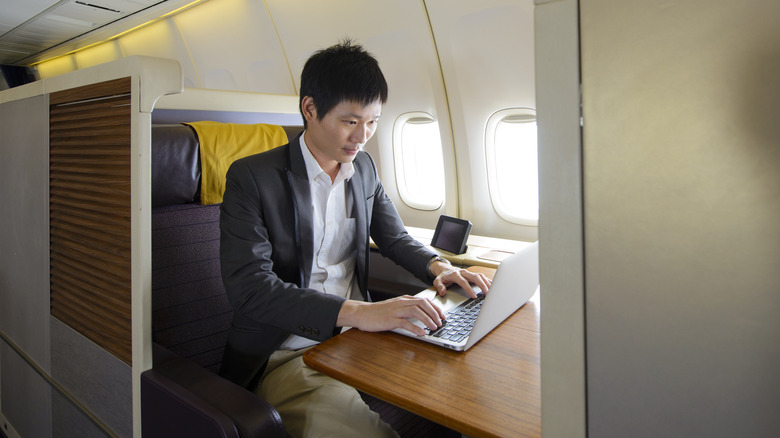Are 'Better' Outfits Really The Secret To Getting Free First Class Upgrades On Flights?
Scoring a complimentary first-class upgrade is the ultimate dream. Unfortunately, it seems to all come down to luck — or choosing the right clothes, according to some people. For years, travelers have been told to upgrade their outfits if they want to snag an upgraded seat. One flight attendant told Who What Wear that passengers are more likely to land a spot in first class by dressing "smart but understated." Another cabin crew member told Express that sandals, sweatpants, and leggings will wreck your chances of being upgraded for free. TikToker @cearakirk also went viral after claiming a flight attendant told her that fliers are sized up at check-in, with well-dressed travelers being marked as "suitable for upgrade."
@cearakirk #greenscreen tips from a flight attendant ✈️ #learnontiktok #travel #traveltips
The advice to choose better outfits for a free upgrade is so prevalent, it's easy to assume it must be true. However, there's little evidence that nice clothes will actually earn you a first-class seat. In reality, airlines have a system for rearranging seats, and clothing isn't usually a consideration when bumping a flier from economy. Moreover, flight attendants can get in trouble for offering free upgrades to passengers just because they look the part.
The myth likely prevails because, at one point, it held some truth. In the 1990s, cabin crew had a bit more leeway when choosing who to upgrade, and a put-together 'fit could have been a factor in some cases. These days, however, that practice is largely unheard of.
Passengers must follow airline dress codes
Another reason why so many people — including airline insiders — may perpetuate the myth of dressing nicely for an upgrade is that flight attendants themselves often have to follow a dress code when flying as a passenger. A cabin crew member explained to Who What Wear that they're expected to wear nice trousers, button-up shirts, blazers, dresses, and other casual business attire when traveling — jeans, sweatpants, and leggings simply aren't allowed. However, these rules won't affect you, unless you happen to be an airline worker who's headed on vacation.
What does apply to you is the airline's standard dress code for passengers, and it impacts everyone on board regardless of their cabin class. For instance, you could get kicked off an airplane if you wear clothes that are too revealing or that allude to violence. The exact rules vary by airline, however. For instance, Delta states that passengers can get booted from the flight for being barefoot or wearing attire that "creates an unreasonable risk of offense or annoyance to other passengers." Similarly, American Airlines requires passengers to "dress appropriately" and avoid "bare feet or offensive clothing." As a rule of thumb, if an outfit isn't appropriate for a visit to an elementary school, it probably won't fly (no pun intended) on a plane either.
How to actually get upgraded to first class for free
Dressing up is one myth to ditch if you're looking for a free airline upgrade, but there are tried-and-true ways to score a complimentary first-class seat. One option is earning elite status with a particular airline, such as by flying regularly with a loyalty number or using an airline credit card to rack up miles. Once you have enough points, you can redeem them for free upgrades and other perks. Besides exchanging points for upgraded seats, you're also more likely to be selected for a free upgrade if you have elite status. For instance, flight attendants typically choose elite members over other passengers when shuffling people around on overbooked flights.
An issue with your flight could also help you land a spot in first class. If you're on an oversold flight and you volunteer to move to another flight, you can ask to have your next seat upgraded to compensate for your trouble (note that this strategy isn't guaranteed to work). You can also report serious problems to the cabin crew, such as a damaged seat belt or broken armrest. If the problem poses a safety risk, you could get moved to an upgraded seat for free. If the issue is more of a nuisance than a hazard, you can still try to negotiate for an upgrade on a future flight.


